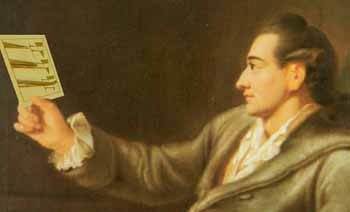| |

Johann Wolfgang Goethe
THE year has come to an end in which we have celebrated the bicentennial birthday of Goethe, the man universally known as a poet, but not so well known as a successful scientist. He busied himself with many fields of science, mineralogy, geology, botany, zoology, osteology, palaeontology, anatomy, chemistry, and physics - especially optics and meteorology. For educational purposes he sponsored the founding of scientific museums, collections, and botanical gardens. And if today institutions of higher learning have their own scientific collections, it should be remembered that the idea originated with Goethe.
It is not generally known that Goethe wrote two books on the theory of colors. After many experiments Goethe first published his theory in 1792 under the title of Contributions to Optics. It took him eighteen more years of uninterrupted hard studies to develop his own theory of optics. His chief work Entwurf einer Farbenlehre is more voluminous than many of his novels. He regarded the Farbenlehre as his most valuable contribution to science. He was proud to be the only man in his century who, as he believed, understood the difficult science of colors, and he thought that he had defeated Newton's theory.
Why did Goethe write his Farbenlehre? While in Italy he tried to paint, but he was not gifted for painting. He wished to compensate this "shortcoming" and to understand painting. He knew of no theory of color, and discussion of tile subject with friends was dull and boring. He was referred to Newton as the great authority. He borrowed some prisms to perform the prescribed experiments, but he postponed experimenting until the very moment when he had to return the prisms.
When he looked through them at a white wall he saw something he had not expected to see, namely, that there were colors only at the edges where the white area was limited by dark parts. He had expected to see the whole wall in diffracted colors. He thought that he had made a fundamental discovery, believing that the limitation of light by darkness caused the generation of colors, or in other words, that colors are a mixture of light and darkness with the help of a mixing medium, the prism. This was the basis of his theory. He refused to think of white light as composed of different colors which could be dispersed by a prism.
This was an unhappy starting point, but Goethe stuck to it in spite of the fact that no physicist accepted it, probably because he had experienced similar refusals of learned specialists who previously had rejected his discovery of a little bone, os intermaxillare; in the upper jaw of the human skull and his theory of the "Urpflanze" (primal plant). These discoveries later became fully recognized and accepted. As a result of this experience Goethe tried to prove his color theory by thousands of experiments, and the more facts had to be explained the bigger grew this theory.
Goethe's approach is contrary to the usual procedure of separating the phenomena till one deals with simple elementary facts. He was afraid that in this process essential changes might take place, distorting reality. Thus, he preferred to make his experiments in the full light of the sun and the moon, or of artificial sources, instead of experimenting in a darkened room with a single beam. His approach to science was that of an artist who thought he could conceive the secrets of nature in all their complexity. Another setback for him was that he did not master mathematics. He was convinced that translation into the language of mathematics was distortion of reality.
Thus he could not succeed in defeating Newton, but from his experimentation came forth a new branch of physics, the physiological optics. The last part of Goethe's Farbenlehre is a history of optics. It starts from ancient times and was intended to be a complete and standardized survey of optics. It is very interesting and worth reading, even today.
Ernest Ising
Bradley University
Peoria, Illinois
|